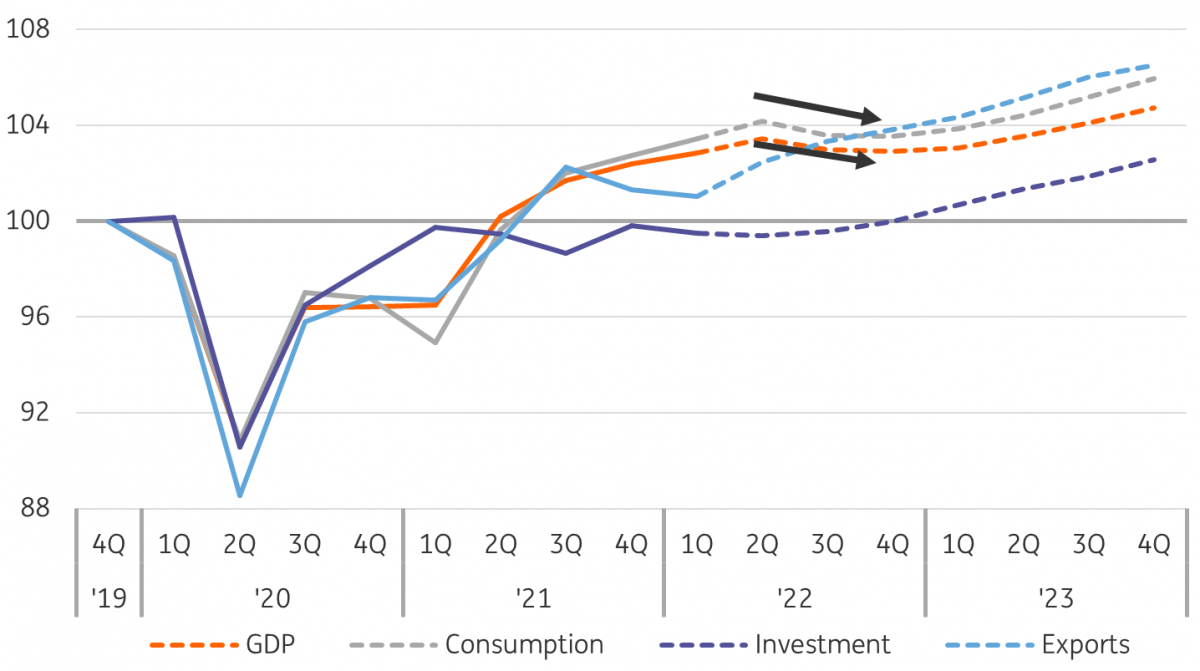The Netherlands: We’re seeing the first signs of weaker demand
Dutch GDP is forecast to grow by a decent 2.9% in 2022 and a mediocre 0.8% next year Expansionary fiscal policy, a tight labour market, and high savings will help a consumer-driven technical recession from turning into a deeper, longer-lasting one
High inflation and low consumer sentiment mean stagflation
A lot of hard data on the Dutch economy is still quite solid. For instance, the unemployment rate is close to record lows and consumption volumes have never been higher than in April. But this is the past; the outlook is somewhat less favourable. ING transaction data suggests a substantial fall in consumer spending in June, seasonally-adjusted Month-on-Month. As this is the first serious signal, it requires careful interpretation. We nevertheless are now forecasting a fall in household consumption in the second half of 2022, as high energy payments, increasing core inflation and record low consumer confidence are expected to weigh on consumers’ budgets. As the amounts deposited on household bank accounts have never been higher and employment is still at record highs, the consumption outlook may not as bad as confidence figures suggest.
Value of consumer transactions declined in June
Change in total value of debit card transactions, cash withdrawals and iDEAL payments of Dutch consumers compared to previous month, seasonally-adjusted

High energy and fuel a problem this year with more to come in 2023
Much of the GDP development currently depends on inflation. The HICP inflation rate is forecast to be very possibly close to double-digit highs in 2022 and still at a 3.9% high in 2023. When you look at the volatile future and forward energy and fuel markets, our forecasts don't see any major fall until winter is over next year. But that contribution to overall inflation rates will fade in 2023. Food inflation is expected to be substantial not only this year but also next.
The following policy measures have a direct effect on the inflation rate for 2022 and 2023, in many cases preventing the 2023 HICP inflation rate from falling towards a more moderate level:
- The energy tax (on gas and electricity) is temporarily lower for 2022. The reversal in 2023 will have an upward effect on inflation for 2023.
- The VAT-rate on energy will be lowered from 21% to 9% for July-December 2022. This has a suppressing effect on inflation this year and an upward effect for 2023.
- The excise duty on fuel (gasoline and diesel) is lowered 21% until December 2022. Also, this measure has a temporary downward effect on inflation in 2022 and an upward effect on for 2023.
- College tuition fees are half of what they used to be and will be normalised in September 2022. This affects the 2023 inflation upwards (+0.3%-points).
- Regulation keeps a lid on the increase of rents in both the social housing sector and the liberalised sector, at least until policy changes as of 1 July 2022 and 1 January 2023. This might be more inflationary for the second half of 2022 and 2023.
- The excise tax on a pack of cigarettes will be increased in two substantial steps, to €10. The first step in April 2023 is estimated to have a nonnegligible effect on the HICP inflation rate of +0.5% in 2023.
Inflation very high in 2022 and high 2023
Change in harmonised index of consumer prices for the Netherlands year-on-year in % and contributions in %-points

Average level of sentiment implies moderate investment outlook
So far, businesses seem to have been holding up quite well, in part because high import inflation was, to a large extent, offset by high increases in the price of exports. As the underlying indicators of the Economic Sentiment Indicator suggest, they are not as pessimistic as consumers. Industry, construction, and commercial services to a lesser extent are still upbeat. The composite sentiment indicator of 29 out of 36 (sub)sectors is still above long-term averages.
All in all, the survey data does not indicate a full-blown recession. But since these figures might still to some extent be influenced by the rebound out of lockdowns, we do pencil in a few quarters with negative growth. This assumes that investment remains more or less unchanged year-on-year, private consumption falls, and exports continue to grow (as service trade still rebounds from the pandemic lows).
Business sentiment in most sectors still decent while consumers gloom
Economic Sentiment Indicator by sector*

Expansionary policy helps recession remain a technical one
The GDP growth figure for 2022 of 2.9% in our base case looks very decent at face value, but most of this is a statistical carry-over from last year. The underlying dynamics are merely in line with stabilisation. As the Netherlands is not as likely to benefit from the tourist season as much as destinations such as Italy, France and Spain, Dutch GDP might already enter a mild technical recession in 2022.
During the course of 2023, GDP should gain some traction again on the back of falling inflation, resulting in an annual growth figure of 0.8%. This growth rate for 2023 is to a large extent supported by the expansionary policies of the Rutte-IV government and requires energy supply issues to remain manageable.
Consumption causes technical recession
Expenditures* as index where fourth quarter of 2019 = 100

The Dutch economy in a nutshell (%YoY)
This publication has been prepared by ING solely for information purposes irrespective of a particular user's means, financial situation or investment objectives. The information does not constitute investment recommendation, and nor is it investment, legal or tax advice or an offer or solicitation to purchase or sell any financial instrument. Read more
Download
Download article
12 July 2022
Eurozone Quarterly: This is going to hurt This bundle contains 11 Articles